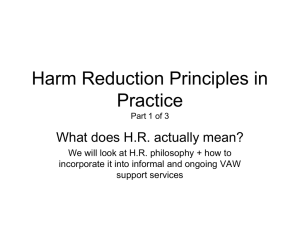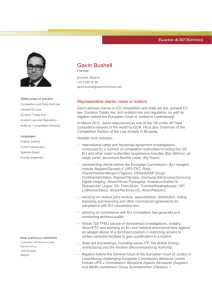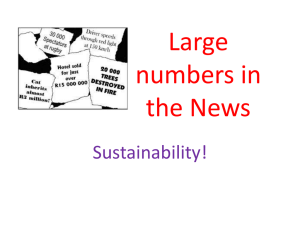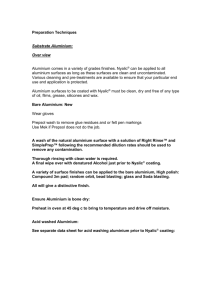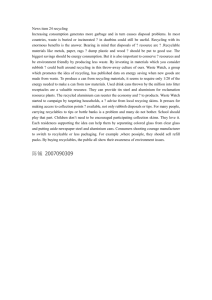DOC - Europa
advertisement
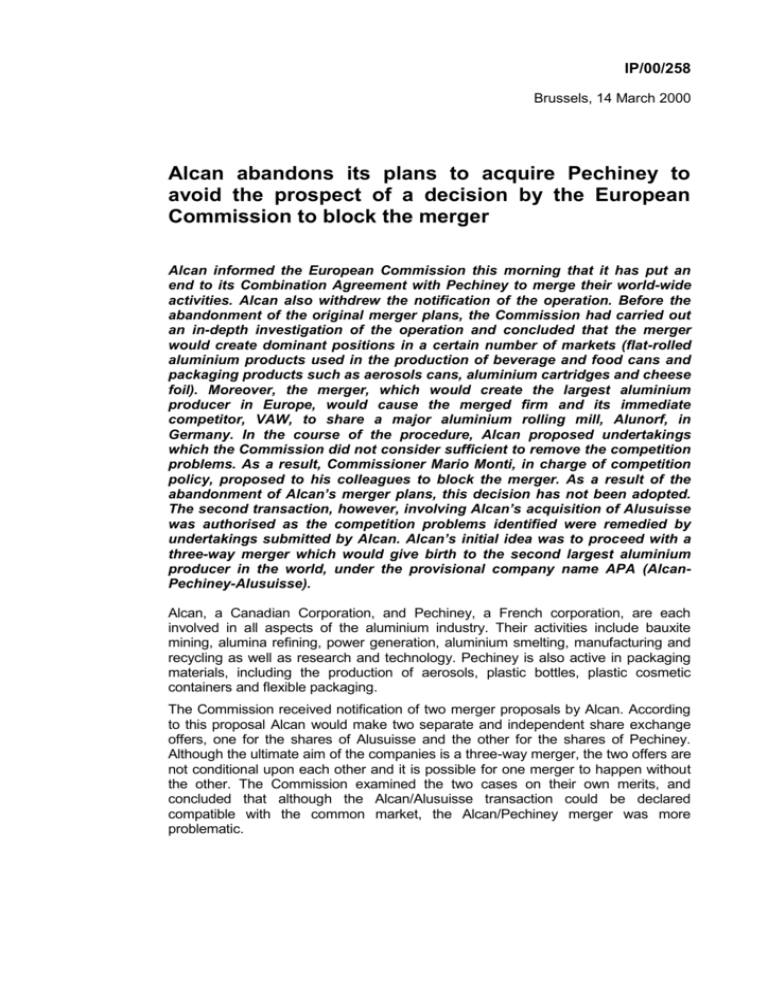
IP/00/258 Brussels, 14 March 2000 Alcan abandons its plans to acquire Pechiney to avoid the prospect of a decision by the European Commission to block the merger Alcan informed the European Commission this morning that it has put an end to its Combination Agreement with Pechiney to merge their world-wide activities. Alcan also withdrew the notification of the operation. Before the abandonment of the original merger plans, the Commission had carried out an in-depth investigation of the operation and concluded that the merger would create dominant positions in a certain number of markets (flat-rolled aluminium products used in the production of beverage and food cans and packaging products such as aerosols cans, aluminium cartridges and cheese foil). Moreover, the merger, which would create the largest aluminium producer in Europe, would cause the merged firm and its immediate competitor, VAW, to share a major aluminium rolling mill, Alunorf, in Germany. In the course of the procedure, Alcan proposed undertakings which the Commission did not consider sufficient to remove the competition problems. As a result, Commissioner Mario Monti, in charge of competition policy, proposed to his colleagues to block the merger. As a result of the abandonment of Alcan’s merger plans, this decision has not been adopted. The second transaction, however, involving Alcan’s acquisition of Alusuisse was authorised as the competition problems identified were remedied by undertakings submitted by Alcan. Alcan’s initial idea was to proceed with a three-way merger which would give birth to the second largest aluminium producer in the world, under the provisional company name APA (AlcanPechiney-Alusuisse). Alcan, a Canadian Corporation, and Pechiney, a French corporation, are each involved in all aspects of the aluminium industry. Their activities include bauxite mining, alumina refining, power generation, aluminium smelting, manufacturing and recycling as well as research and technology. Pechiney is also active in packaging materials, including the production of aerosols, plastic bottles, plastic cosmetic containers and flexible packaging. The Commission received notification of two merger proposals by Alcan. According to this proposal Alcan would make two separate and independent share exchange offers, one for the shares of Alusuisse and the other for the shares of Pechiney. Although the ultimate aim of the companies is a three-way merger, the two offers are not conditional upon each other and it is possible for one merger to happen without the other. The Commission examined the two cases on their own merits, and concluded that although the Alcan/Alusuisse transaction could be declared compatible with the common market, the Alcan/Pechiney merger was more problematic. Summary of the Commission’s analysis Today, the Commission was to decide on Commissioner Monti’s proposal to block the Alcan/Pechiney transaction. The investigation showed that the merged firm would hold substantial market shares conferring it with a dominant position in the markets for aluminium beverage can body stock (a raw material used in the production of beverage cans) and for aluminium food can sheet (a raw material used in the production of food cans). Moreover, the merged entity would become the dominant player in a number of packaging markets, in particular aluminium aerosol cans, aluminium cartridges and aluminium flexible packaging for processed cheese. In addition, Alcan is a 50:50 joint partner of VAW, in the largest aluminium rolling mill world-wide, Alunorf, in Germany. As a result of the merger, VAW, Alcan and Pechiney, that is the three largest aluminium producers in the EU, would produce their products in the same facility. This situation would have induced parallel anticompetitive competitive behaviour between the Alunorf partners, which would ultimately harm competition and consumers. In order to alleviate the competition concerns identified by the Commission, the merging firms proposed a series of undertakings. These aimed at reducing the merged firm’s market shares in the various problematic markets, as well as at loosening the link between competitors in the Norf joint venture. The Commission did not consider these undertakings fully satisfactory. This assessment was confirmed by the negative results of the market test. As a consequence, Commissioner Monti decided to submit a prohibition decision to the Commission, as the proposed merger would result in the creation of several dominant positions as a result of which effective competition would be impeded in the common market. 2 ANNEX TO THE PRESS RELEASE Details of the Commission’s analysis Flat-rolled products The Commission identified concerns which led it to conclude on the creation of a dominant position in the markets for beverage can body stock and food can sheet. These concerns were particularly aggravated by the presence of the Norf joint venture between the merged firm and its immediate competitor in these markets, VAW. Beverage can body stock is the raw material for the manufacture of beverage cans. The Commission’s detailed investigation led it to conclude that aluminium and tinplate beverage can body stock are not part of the same product market. The geographic market for beverage can body stock is the EEA. The merger would result in a significant combined market share with the remaining competitors (VAW of Germany and Elval of Greece) lacking well behind. Those could not be regarded as a competitive threat to the possible exercise of market power by the merged firm. Elval is, at present, too small to capture market share from the merged firm, unless it invests heavily in capacity expansions. VAW produces all of its beverage can stock at Norf and is linked to the merged firm through that joint venture. Its incentives to compete would diminish significantly after the merger. VAW has capacity constraints, which is not the case for the merged firm. If VAW wanted to compete head-on, it would have to expand its capacity at Norf. This could be blocked by the merged firm under the Norf joint venture agreements. Moreover, the arrangements on the cost allocation between the two partners at Norf give the possibility to the merged firm to raise VAW’s costs, by simply re-arranging its product mix at Norf. This represents a credible threat of retaliation at the disposal of the merged firm. Under these circumstances, the most rational course of action to be followed by VAW was to align its behaviour on that of the merged firm and become a price taker. No mitigating circumstances to the market power of the merged firm were found to exist. Consequently, the Commission considered that the Alcan/Pechiney transaction would create a dominant position in the market for beverage can body stock. The merger would also create a dominant position in the market for food can sheet. This is the raw material for the manufacture of food cans. Although food cans are made of either tinplate or aluminium, aluminium and tinplate can sheet were found to be two separate product markets. From a geographic viewpoint, competition in this market takes place within the EEA. The combined market share of the merged firm would be substantial whereas the next competitor, VAW, would have five times smaller a market share. However, as for beverage can body stock, VAW’s incentives to compete would be reduced as a result of its participation along with the merged firm in the Norf joint venture. The remaining competitors are small and capacityconstrained so as not to be able to capture market share from the merged firm. For these reasons, the Commission considered that the concentration would result in the creation of a dominant position in the market for food can sheet in the EEA. 3 The Norf joint venture between Alcan and VAW One of the crucial features in the Commission’s analysis was the existence of Aluminium Norf GmbH (“Norf”), a 50:50 joint venture rolling mill between Alcan and VAW. Alcan had argued that the Norf joint venture is not a classical production joint venture but a time sharing facility, which would not restrict competition between the parent companies, as a result of the merger. However, the Commission considered that the degree of interdependence between Alcan and VAW stemming from the joint operation of Norf prevented it from qualifying as a simple time sharing facility. The presence of the two largest EEA producers of aluminium flat-rolled products in a joint structure that manufactures products in which the merged firm will acquire significant market positions, raises competition problems. These stem from the legal structure of Norf and the resulting de facto co-operation between the parents; from the strong dependence of VAW on Norf, its capacity constraints in other rolling mills and the right of Alcan to veto investments proposals by VAW aiming at increasing its capacity; and the ability of the merged firm to raise VAW’s costs by changing unilaterally its product mix at Norf. Overall, the asymmetrical capacity constraints, in favour of the merged firm, and the credible threat of retaliation on VAW would create a situation where collusion among the parents of Norf could be sustainable in the long run. Undertakings in relation to flat-rolled products and the Norf joint venture In order to eliminate the competition problems identified by the Commission, Alcan proposed a package of undertakings. Concerning beverage can body stock and food can sheet, the merger would bring about the combination of Alcan’s Norf and Pechiney’s Neuf-Brisach rolling mills, where these products are produced. Alcan proposed to make available to a third party, its rolling capacity at Norf, corresponding to the production of beverage can body stock and food can stock (corresponding to 20% of Alcan’s rolling activity in Norf). Moreover, Alcan would cease the production of these products at Norf, for a long period of time. Overall, the merged entity would remain a partner in Norf, although on a reduced capacity basis. This proposal was not acceptable to the Commission. First, it would not severe the link between the two largest aluminium producers in Europe (APA and VAW). Secondly, if another aluminium producer were to acquire Alcan’s share of capacity in Norf, then a joint venture between three, and probably the only, suppliers of beverage can body stock would occur. This would increase the already extremely high concentration of the European aluminium industry. Therefore, this solution could not be accepted. On the other hand, if VAW were to acquire Alcan’s divested capacity share in Norf, this would remove the competitive overlap between Alcan and Pechiney, but it would create two players with symmetrical market positions which, in addition, would share the Norf mill. Given the structure of the market and the links between APA and VAW, the creation of a duopolistic dominant position held by the merged firm and VAW in the beverage can body stock market could not be excluded. 4 It is precisely in order to address such duopolistic dominance doubts that Alcan offered an additional measure: to make available to a third party, for a certain period, a capacity of several thousands tonnes of beverage can body stock from Pechiney’s Neuf-Brisach mill. This tonnage corresponds to a small, but not insignificant, share of the market. In exchange, the third party would make available to APA an equivalent capacity of foil stock and the price differential between the two products will be compensated through a conversion formula. Overall, through this additional measure, the parties considered that a third player with a given market share would become active in this market, therefore dispelling any doubts as to the creation of a duopolistic market structure. However, the Commission considered it doubtful whether such a proposal could really dispel a possible duopoly. Firstly, the third party would be strongly dependent on Neuf-Brisach; it would be no more than a wholesaler of the APA’s Neuf-Brisach mill. Indeed, the third party would not be involved at all in the production process; it would just be entitled to sell the material to can makers, most probably without even coming into contact with it. Secondly, it would be constrained to a given amount of capacity and unlikely to compete against the APA or VAW for market share. It is unlikely that such a third party would ever become a real and independent competitor. On the contrary it is rather likely that it would align its behaviour and prices on those of the merged firm. Thirdly, it is not certain at all whether, after the expiry of the start-up period, the third party would commit to continue producing and supplying beverage can body stock on its own or whether it would stop this activity once the Neuf-Brisach supply agreement had elapsed. Overall, the proposed undertaking was not considered able to eliminate the creation of a dominant position in the relevant product markets. Undertakings in respect of Norf In order to address the Commission’s concerns as to the cohabitation of APA and VAW in the Norf joint venture, Alcan proposed to remain a joint partner in Norf, in exchange of loosening the joint venture link. Alcan proposed undertakings in order to remove (i) the concerns about the flow of confidential information between the parent companies, by putting in place confidentiality obligations and firewalls between the APA and VAW; (ii) the concerns about Alcan’s possibility to raise VAW’s costs by changing its product mix at Norf, by proposing to amend the current Norf cost allocation formula so as to ensure that no action of APA would negatively affect the costs to be borne by VAW at Norf; and (iii) the concerns about Alcan’s right to block investments aiming at expanding VAW’s capacity at Norf, by proposing to amend the provisions relating to capacity expansions and allow any party to expand capacity at Norf unilaterally. Overall, Alcan offered undertakings which provide for the amendment of its existing joint venture agreements with VAW. However, these undertakings cannot be performed by Alcan alone but can only be implemented with the prior agreement of VAW. Besides the fact that these undertakings were not self-executing, the Commission did not consider them able to eliminate the risk of collusion at Norf. First, the undertaking relating to the veto right on investments concerns only investments related to the installation of new facilities at Norf (i.e., a new rolling mill). All the remaining investments were not caught by the undertaking (i.e., debottlenecking of current capacities, maintenance work, modernisation of working methods and other day-to-day improvements). 5 Moreover, the undertaking was qualified, in that Alcan would not veto any expansion by VAW provided that such expansion would not “adversely affect the existing operations of the other party at Alunorf”. This provision would be subject to interpretation and highly likely to give raise to vivid discussions between APA and VAW. Secondly, as to the undertaking to put in place “stringent confidentiality procedures” at Norf, the Commission considered that besides the fact that such ‘firewalls’ could not be effectively monitored, any confidentiality procedures with respect to production schedules and sales forecasts could adversely affect the functioning and competitiveness of Norf. Indeed, if the parent companies are selective as to the information they will pass on to the Norf production staff, then Norf could not co-ordinate and optimise its production process in advance but would have to wait for each individual order put by the parents up to the total capacity which they are entitled to use. Consequently, no standardisation with respect to the alloys, routing or other production processes would be possible, due to the fact that no forecast business plan could be established. Ultimately, this would harm only VAW, as APA’s relative dependence on Norf would be reduced after the merger owing to the other rolling mills that the merging partner would bring together. Overall, neither the undertakings concerning the specific product markets nor those concerning the link of APA and VAW in Norf were able to eliminate the competition problems identified by the Commission throughout the procedure. The packaging markets The merger also raised competition problems in three packaging markets, namely aluminium cartridges, aerosol cans and cheese foil. Although Alcan does not produce aerosol cans and cheese foil, the merger would bring together the respective businesses of Alusuisse (which Alcan was authorised by the Commission to acquire) and Pechiney in those products. Aluminium cartridges are used to pack sealants and adhesives used in the car and construction industry. The Commission found that the merger would create the dominant producer and supplier of aluminium cartridges in the EEA. As far as aerosol cans are concerned, the Commission found that tinplate and aluminium aerosol cans do not belong to the same product market. There is a specific demand for aluminium aerosol cans, motivated by the superior characteristics of that metal. Competition takes place at EEA level. The merged firm would have a considerable share of the aluminium aerosol cans market, six times higher than its nearest rival. Moreover, it would control by far the largest share of overcapacity, which exceeds the production capacity of any of the smaller suppliers, placing thus the merged firm in the best position to win a price war. The Commission concluded that the proposed concentration would lead to a dominant position in the EEA market for aluminium aerosol cans. Finally, in the market for flexible packaging for cheese (cheese foil), the merged firm would have a large market share, three times higher than that of the nearest rival. Moreover, the merged firm would be the only supplier with dedicated production line for cheese foil which would give the new company a considerable cost advantage over rivals. The Commission concluded that the proposed concentration would lead to a dominant position in the EEA market for lacquered aluminium foil for the packaging of cheese. 6 Undertakings proposed by Alcan in relation to the packaging markets In order to eliminate the competition problems identified by the Commission, Alcan proposed a package of undertakings. As far as aerosol cans are concerned, Alcan offered to sell two plants (Bellegarde in France and Badalona, in Spain) and half of the Hanko plant in Finland. In addition, a certain amount of can lines would be transferred to Bellegarde after the closure of the Nürnberg plant, Germany. The results of the Commission’s analysis of the undertakings have shown that the proposed undertaking would not remove the competitive overlap and would leave APA with a substantial part of the market. In addition, the proposed plants were, reportedly, not viable or are high cost facilities which were meant to be shut down anyway. Moreover, the Commission strongly questioned the likelihood that the acquirer of these plants would be able to build up a competitive business, in particular given that the full transfer of the divested business and the integration and establishment process would take a number of years to complete. During that time, transferred customers would not receive a flawless service and would have a fully operational alternative to go in the event of problems, that is, APA. Consequently, the proposed undertaking was not considered sufficient to eliminate the competition problem identified by the Commission. In relation to cartridges, Alcan produces this material in Göttingen, Germany and Pechiney in Saumur, France. Alcan offered to sell either its own or Pechiney’s cartridge plant. The proposed sale seems to eliminate the competitive overlap and restore the status quo ante prevailing before the merger. However, the Commission pointed out that the undertaking was not firm, but remained vague and ambiguous as to the specific plant that will be finally sold. Finally, in relation to cheese foil, Alcan proposed to grant a licence to a third party in respect of its technology used in the lacquering of aluminium foil for wrapping processed cheese or to sell a line that is capable of lacquering aluminium foil for wrapping processed cheese together with a licence of the technology used in respect of the relevant line. In addition, Alcan proposed to offer a supply contract for the lacquered foil to ensure that the licensed competitor will be fully operational before the supply agreement expires. The Commission considered that the proposed undertaking were not sufficient to remove the competition problem identified. The undertaking is vague as to whose party’s technology or production line will be divested. Furthermore, the transfer of technology, short of the transfer of a manufacturing site, would not be sufficient to enable a third party acquirer to generate a production capacity equivalent to the amount of the overlap. Therefore, the overlap of activities would remain in place. Moreover, it is doubtful whether such a third party acquirer would be able to swiftly integrate and assimilate the transferred technology within its business in the short to medium term. A possible delay would make the third party acquirer non competitive in this market while the dominant position of the parties would remain. Furthermore, a third party acquirer might not be able to adapt its research and development efforts on the transferred technology so as to fully exploit the benefits of such technology in the future. Overall, a mere transfer of technology would not enable the new acquirer to establish itself in the market and get the necessary approvals and accreditation from customers so as to become a viable and independent competitor of APA. 7 The same considerations apply to the alternative proposal to sell a line capable of lacquering aluminium foil for wrapping processed cheese together with a licence of the technology. The proposed solution would not eliminate the overlap. The merged firm would keep its current business, including customer contracts and accreditations. The mere sale of a production line also posed the problem of accreditation with customers. The Commission gathered evidence of cases where the established suppliers of cheese foils were discredited by customers because of the simple fact that they moved some of their production from one site to another. This resulted in poorer quality product and to the removal of the accreditation by customers. It is, therefore, doubtful whether a third party acquirer would be able to produce and commercialise a marketable product so as to challenge the dominant position of the merged firm. Finally, Alcan did not propose the transfer of customer contracts and accompanying non-competition and non-solicitation clauses. Therefore, the Commission considered that the proposed undertaking was not sufficient to prevent the creation of a dominant position. 8
